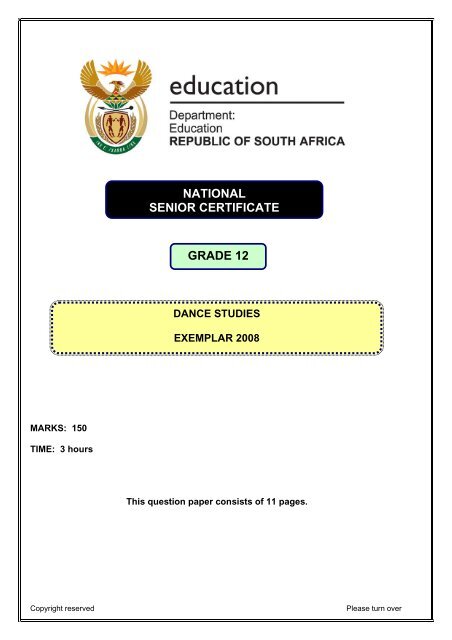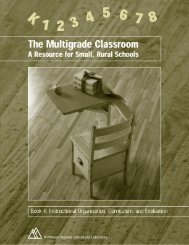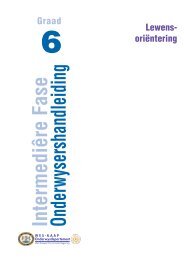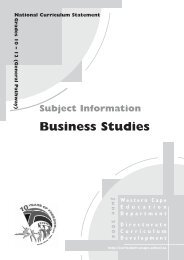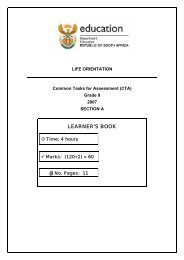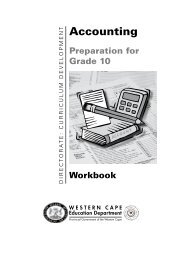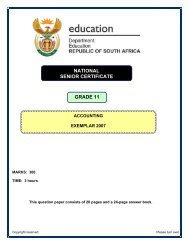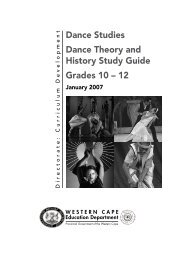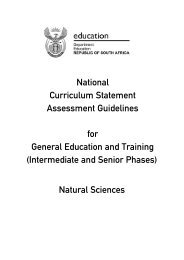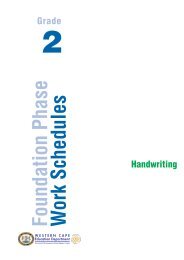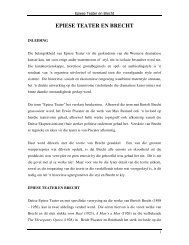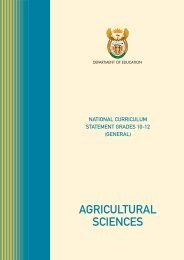Dance Studies Grade 12 Exemplar Paper 1 - Thutong
Dance Studies Grade 12 Exemplar Paper 1 - Thutong
Dance Studies Grade 12 Exemplar Paper 1 - Thutong
You also want an ePaper? Increase the reach of your titles
YUMPU automatically turns print PDFs into web optimized ePapers that Google loves.
NATIONAL<br />
SENIOR CERTIFICATE<br />
GRADE <strong>12</strong><br />
DANCE STUDIES<br />
EXEMPLAR 2008<br />
MARKS: 150<br />
TIME: 3 hours<br />
This question paper consists of 11 pages.<br />
Copyright reserved<br />
Please turn over
<strong>Dance</strong> <strong>Studies</strong> 2 DoE/<strong>Exemplar</strong> 2007<br />
NSC<br />
INSTRUCTIONS AND INFORMATION<br />
1.<br />
2.<br />
Read ALL the questions carefully.<br />
Note that there are choices between questions and within questions.<br />
You have choices between:<br />
QUESTION 1.1 and 1.2<br />
QUESTION 3 and 4<br />
QUESTION 5.1 and 5.2<br />
QUESTION 11 and <strong>12</strong><br />
QUESTION 13.1 and 13.2<br />
QUESTION 14 and 15<br />
3.<br />
4.<br />
5.<br />
6.<br />
7.<br />
8.<br />
Leave THREE lines after EACH answer.<br />
Begin EACH section on a NEW page.<br />
Number the answers correctly according to the numbering system used in this<br />
question paper.<br />
ALL answers must be written in the ANSWER BOOK.<br />
Marks are NOT allocated per fact. In your answers, elaborate and explain as<br />
much as possible.<br />
Write neatly and legibly.<br />
Copyright reserved<br />
Please turn over
<strong>Dance</strong> <strong>Studies</strong> 3 DoE/<strong>Exemplar</strong> 2007<br />
NSC<br />
SECTION A: DANCE THEORY AND HISTORY<br />
QUESTION 1<br />
Answer EITHER QUESTION 1.1 OR 1.2<br />
PRESCRIBED DANCE WORKS<br />
South African<br />
Choreographers <strong>Dance</strong> Works<br />
International<br />
Choreographers <strong>Dance</strong> Works<br />
Veronica Paeper Orpheus in the George Balanchine Apollo or Agon<br />
Underworld<br />
Vincent Mantsoe Gula Matari Alvin Ailey Revelations<br />
Alfred Hinkel Last <strong>Dance</strong> (Bolero) Martha Graham Appalachian Spring or<br />
Lamentation<br />
Sylvia Glasser Tranceformations Christopher Bruce Ghost <strong>Dance</strong>s or Rooster<br />
Gary Gordon Bessie's Head Marius Petipa and Swan Lake<br />
Lev Ivanhof<br />
Mavis Becker Flamenco de Africa Vaslav Nijinski Le Sacre du Printemps<br />
Hazel Acosta Blood Wedding Paul Taylor Esplanade<br />
Caroline Holden Imagenes<br />
1.1 Select ONE choreographer from the list above. Write an article for a dance<br />
magazine about this choreographer. Include the following information in no<br />
particular order: (Remember to give your article a heading and also include the<br />
name of the choreographer you are referring to. Do NOT use the numbering in<br />
your answer.)<br />
1.1.1<br />
1.1.2<br />
1.1.3<br />
1.1.4<br />
1.1.5<br />
Biographical information, including country of origin and career<br />
(training and experience)<br />
Output (well-known dance works)<br />
Influences and collaborations<br />
Time period, social and political context<br />
Contributions to the development of dance<br />
(Marks awarded for presenting the information as a magazine<br />
article.)<br />
OR<br />
(3)<br />
(3)<br />
(4)<br />
(4)<br />
(4)<br />
(2)<br />
[20]<br />
1.2 Select ONE prescribed dance work from the list above. Write a review for a<br />
dance magazine. Remember to include the title of the dance work and<br />
choreographer. Do NOT use the numbering in your answer. Include the<br />
following information:<br />
1.2.1<br />
1.2.2<br />
Names of others involved in the dance work, for example the<br />
composer, designers, company<br />
Details about the performance such as dance form, style and period<br />
(3)<br />
(3)<br />
Copyright reserved<br />
Please turn over
<strong>Dance</strong> <strong>Studies</strong> 4 DoE/<strong>Exemplar</strong> 2007<br />
NSC<br />
1.2.3<br />
1.2.4<br />
1.2.5<br />
Background to the choreography, for example period, social or<br />
political context<br />
Description of the dance, theme, structure and design (sets,<br />
costumes, lighting) and how they enhanced the work<br />
Your impression of the impact of the dance work<br />
(Marks awarded for presenting the information as a review.)<br />
(4)<br />
(6)<br />
(2)<br />
(2)<br />
[20]<br />
QUESTION 2<br />
<strong>Dance</strong> can be seen as symbolic language. Referring to any of the prescribed dance<br />
works you have studied, write an essay explaining how symbolism has been used to<br />
communicate ideas, messages or stories. Name the dance work and choreographer<br />
you are referring to.<br />
Make sure you do NOT write about the same choreographer or dance work as in<br />
QUESTION 1. Remember to write in essay format and NOT to use numbering.<br />
Include the following information:<br />
2.1<br />
2.2<br />
2.3<br />
The background and period that informed the choreography<br />
The symbolism used and its meaning<br />
How the choreographer used the symbolism, for example through choice of<br />
movements, music, costumes, make-up, set, lights or any other effects he/she<br />
selected<br />
(5)<br />
(5)<br />
(5)<br />
[15]<br />
Answer EITHER QUESTION 3 OR QUESTION 4<br />
QUESTION 3<br />
You have just graduated from a dance programme and would like to run a dance<br />
community project in a disadvantaged area. A local company has offered you the use<br />
of a large, unoccupied space on their premises. They have agreed to sponsor you to<br />
get an upliftment programme running and have asked you to submit a proposal of what<br />
you will need to start it off. Include the following in your proposal:<br />
3.1<br />
3.2<br />
3.3<br />
The name and a brief explanation of the project<br />
The needs of the project in detail (for example role players and resources)<br />
and how you will sustain the project<br />
An explanation of how the community will benefit and also how the sponsor<br />
will benefit from their contribution<br />
OR<br />
(5)<br />
(7)<br />
(3)<br />
[15]<br />
Copyright reserved<br />
Please turn over
<strong>Dance</strong> <strong>Studies</strong> 5 DoE/<strong>Exemplar</strong> 2007<br />
NSC<br />
QUESTION 4<br />
You are a freelance choreographer and have been commissioned to create a major<br />
dance work to be presented at a dance festival in a theatre in your province. You have<br />
already auditioned and employed a group of professional dancers.<br />
What OTHER essential performance/production professionals would you need to work<br />
with? Name at least FIVE. Elaborate on the skills and knowledge you expect these<br />
people to have, and how you want them to contribute towards the success of your<br />
work. [15]<br />
QUESTION 5<br />
Answer EITHER QUESTION 5.1 OR QUESTION 5.2.<br />
5.1 You have studied ceremonial ritual dance. Provide the following information:<br />
5.1.1<br />
5.1.2<br />
5.1.3<br />
Name of the ritual dance you have studied, the society that<br />
performs this particular dance and the purpose of the dance<br />
Description of the costumes, music and movements used<br />
A paragraph explaining what makes it ritualistic<br />
OR<br />
(3)<br />
(3)<br />
(4)<br />
[10]<br />
5.2 You will be attending a traditional, indigenous dance performance with your<br />
class.<br />
Write down 10 relevant questions to guide you, on what to take notice of to<br />
enable you to write a review. Do NOT write the actual review. [10]<br />
Copyright reserved<br />
Please turn over
<strong>Dance</strong> <strong>Studies</strong> 6 DoE/<strong>Exemplar</strong> 2007<br />
NSC<br />
QUESTION 6<br />
6.1 Study the posters below and answer the questions that follow.<br />
POSTER 1 POSTER 2<br />
6.1.1<br />
6.1.2<br />
When you look at each of the posters, which one do you think is<br />
most effective and why? Substantiate your answer.<br />
Does each of the posters get the necessary information across to<br />
you and how is this done?<br />
(2)<br />
(2)<br />
6.2 Answer the following questions:<br />
6.2.1<br />
6.2.2<br />
6.2.3<br />
How do posters attract attention?<br />
How do posters communicate quickly?<br />
How can posters evoke emotions?<br />
(2)<br />
(2)<br />
(2)<br />
[10]<br />
TOTAL SECTION A: 70<br />
Copyright reserved<br />
Please turn over
<strong>Dance</strong> <strong>Studies</strong> 7 DoE/<strong>Exemplar</strong> 2007<br />
NSC<br />
SECTION B: MUSIC<br />
QUESTION 7<br />
Choose a term from COLUMN B that matches a description in COLUMN A. Write only<br />
the letter (A – D) next to the question number (7.1 – 7.4) in the ANSWER BOOK.<br />
COLUMN A<br />
COLUMN B<br />
7.1<br />
7.2<br />
7.3<br />
7.4<br />
Lower or higher notes<br />
Music made up of several tunes occurring at the same<br />
time<br />
Musical signs indicating short or long silences<br />
A musical style derived from Negro slavery days in the<br />
Unites States of America<br />
A<br />
B<br />
C<br />
D<br />
blues<br />
rests<br />
pitch<br />
polyphonic<br />
(4 x 1) [4]<br />
QUESTION 8<br />
8.1 From the list of dance rhythms below, identify ONE for EACH of the time<br />
signatures:<br />
polka; tango; habanera; kwaito; maskandi; waltz; minuet; mazurka;<br />
rumba; samba; paso doble<br />
8.1.1<br />
8.1.2<br />
8.1.3<br />
8.1.4<br />
3/4<br />
2/4<br />
4/4<br />
6/8<br />
(1)<br />
(1)<br />
(1)<br />
(1)<br />
8.2 For EACH of the time signatures below, write TWO bars of music using<br />
minims, crochets, quavers, semiquavers or rests:<br />
8.2.1<br />
8.2.2<br />
QUESTION 9<br />
3/4<br />
4/4<br />
(2)<br />
(2)<br />
[8]<br />
Select a music genre that you have become familiar with in your dance studies.<br />
Analyse its unique identifying characteristics and name at least TWO types of musical<br />
instruments that are commonly used in this genre. [4]<br />
QUESTION 10<br />
Choose ONE of the dance works you have studied and give the following musical<br />
information of this work.<br />
10.1<br />
10.2<br />
Name of the work, choreographer and composer<br />
The style of the music and how it enhances the dance work<br />
(1)<br />
(3)<br />
[4]<br />
Copyright reserved<br />
TOTAL SECTION B: 20<br />
Please turn over
<strong>Dance</strong> <strong>Studies</strong> 8 DoE/<strong>Exemplar</strong> 2007<br />
NSC<br />
SECTION C: ANATOMY AND HEALTH CARE<br />
Answer EITHER QUESTION 11 OR QUESTION <strong>12</strong>.<br />
QUESTION 11<br />
11.1 Name any SEVEN of the muscles labelled A to J in the diagrams below.<br />
Write the names of the seven muscles next to the letter (A – J) in the<br />
ANSWER BOOK.<br />
F<br />
A<br />
E<br />
D<br />
B<br />
J<br />
G<br />
C<br />
H<br />
I<br />
(7)<br />
11.2 Name the type of joint found in the following:<br />
11.2.1<br />
11.2.2<br />
The knee and explain what type of movements are possible in this<br />
joint<br />
The hip and explain what type of movements are possible in this<br />
joint<br />
(3)<br />
(6)<br />
[16]<br />
Copyright reserved<br />
OR<br />
Please turn over
<strong>Dance</strong> <strong>Studies</strong> 9 DoE/<strong>Exemplar</strong> 2007<br />
NSC<br />
QUESTION <strong>12</strong><br />
<strong>12</strong>.1<br />
<strong>12</strong>.2<br />
Name the type of joint found in the hip and what movements are possible in<br />
that joint.<br />
If you had to perform a plié (knee bent in standing position) in parallel, which<br />
muscles would be the prime movers in executing the movement, and what<br />
anatomical action would be taking place in the joints associated with the<br />
movement? (Use the correct anatomical terminology, for example plantar<br />
flexion, NOT pointing.)<br />
(6)<br />
<strong>12</strong>.2.1<br />
<strong>12</strong>.2.3<br />
Describe the actions and muscles involved in the downward<br />
movement.<br />
Describe the actions and muscles involved in the upward<br />
movement.<br />
(6)<br />
(4)<br />
[16]<br />
QUESTION 13<br />
Answer EITHER QUESTION 13.1 OR QUESTION 13.2.<br />
13.1 Name and explain FOUR types of safe stretching techniques that could be<br />
used to increase flexibility in the joints. Provide THREE tips for safe<br />
stretching. [9]<br />
OR<br />
13.2 Describe what happens in voluntary muscles when they are stretched.<br />
Include in your explanation how these muscles respond to involuntary<br />
reflexes. [9]<br />
Answer EITHER QUESTION 14 OR QUESTION 15.<br />
QUESTION 14<br />
Listed below are three common dance injuries. Supply the relevant information on the<br />
CAUSES AND TREATMENT of these injuries.<br />
A. Cramps<br />
B. Pulled muscles (also known as first degree sprain)<br />
C. Shin splints<br />
(5)<br />
(5)<br />
(5)<br />
[15]<br />
OR<br />
Copyright reserved<br />
Please turn over
<strong>Dance</strong> <strong>Studies</strong> 10 DoE/<strong>Exemplar</strong> 2007<br />
NSC<br />
QUESTION 15<br />
15.1<br />
All the information you have gathered about the principles of body<br />
conditioning and fitness are critical to your development as a dancer. It is<br />
important that you are aware of this whenever you dance.<br />
15.2<br />
Keeping this in mind, create a mind map of the different components of fitness<br />
that you understand to be vital in your training and development. (See the<br />
example of a mind map given below.)<br />
Select ONE of the fitness components from your mind map and explain why it<br />
is vital and how to address it in your training<br />
(9)<br />
(6)<br />
Body conditioning<br />
and fitness<br />
mind map<br />
[15]<br />
Copyright reserved<br />
Please turn over
<strong>Dance</strong> <strong>Studies</strong> 11 DoE/<strong>Exemplar</strong> 2007<br />
NSC<br />
QUESTION 16<br />
Good posture and balance involves the awareness of the correct alignment of the<br />
spine and the development of core stability.<br />
A<br />
B<br />
C<br />
16.1<br />
16.2<br />
16.3<br />
The muscles shown in the diagram above are some of those involved in<br />
maintaining posture. Label A, B and C. Write the names of the muscles next<br />
to the letter (A – C) in the ANSWER BOOK.<br />
How would you explain good posture and core stability training to an<br />
inexperienced dancer?<br />
Describe ONE exercise you could do to develop strength in the muscles<br />
labelled A – C.<br />
(3)<br />
(4)<br />
(3)<br />
[10]<br />
QUESTION 17<br />
Stereotyping can be damaging, leading to feelings of low self-esteem and teasing.<br />
Listed below are some of the most commonly used dance stereotypes. State why one<br />
should disagree in each case.<br />
17.1<br />
17.2<br />
17.3<br />
17.4<br />
<strong>Dance</strong>rs must be thin.<br />
Dancing is effeminate and all male dancers are gay.<br />
<strong>Dance</strong> is not intellectually challenging so it is a better option for students who<br />
are not 'academic'.<br />
People with disabilities cannot dance.<br />
(2)<br />
(2)<br />
(2)<br />
(4)<br />
[10]<br />
TOTAL SECTION C: 60<br />
GRAND TOTAL: 150<br />
Copyright reserved


